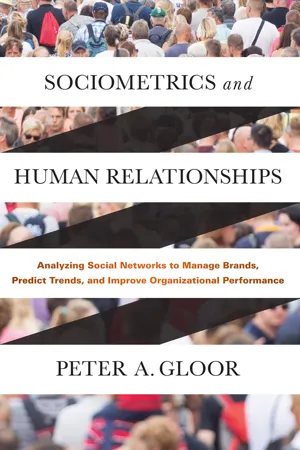
- 512 pages
- English
- ePUB (mobile friendly)
- Available on iOS & Android
Sociometrics and Human Relationships
About This Book
Sociometrics and Human Relationships translates the latest academic research into practical business strategies and techniques as well as actionable insights, providing a wealth of examples for social network analysis and predicting trends. Gloor illustrates how to improve organizational performance by optimizing communication and collaboration through email. Based on Collaborative Innovation Networks courses which have been taught for over a decade to students forming virtual teams across a number of universities, Gloor shows readers how to leverage virtual collaborative creativity in the Internet age, and helps them understand and apply the dynamics of online communication via a variety of tools. Gloor has also created a tool that analyses all types of social media such as: Twitter, Wikipedia, online blogs and Facebook as well as email or Skype logs to predict election outcomes, perception and strength of brands, customer and employment satisfaction, or fraudulent behavior. Gloor explains how to use his tool, Condor, to visualize, monitor and manage brands, products and topics online, as well as analyzing organizations through their email networks.
Frequently asked questions
Information
1
INTRODUCTION

- – Find out about the happiness of your employees (see Section 9.3).
- – Find out about the satisfaction of your customers (see Section 9.3).
- – Find out who might be leaving your company (see Section 9.3).
- – Find your most creative and motivated employees (see Chapter 10).
- – Find out about the willingness of your employees to take unnecessary risks (see Section 11.3).
- – Find out about what your customers and prospects really think about your company and your brands (see Chapter 12).
- – Measure the strength of your brand (see Chapter 12).
- – Find out about the demographic profile of the customers and aficionados of your company and brands (see Section 14.3).
- – Forecast the popularity and voter share of a politician (see Section 14.2).
- – Find out about the demographic profile of the voters of a politician (see Section 14.3).

1.1. ROADMAP
1.1.1. Part I — Trend Prediction by Analyzing Social Networks
- Chapter 2, Coolfarming Organizations
This chapter describes the key principles of how innovation can be improved by better collaboration and better communication. It shows how by analyzing social networks at companies through mining online communication archives, such as e-mail, skype, calendars, and phone logs works, and how through virtual mirroring organizational performance can be optimized. - Chapter 3, Coolhunting and Trend Forecasting on the Web
This chapter gives an introduction to the key principles of Coolhunting. Coolhunting measures global consciousness by analyzing the wisdom (and madness) of the crowd on Twitter, the (paid) wisdom of experts on blogs and online newspapers, and the wisdom of swarms on Wikipedia, Facebook groups, and online forums. - Chapter 4, The Six Honest Signals of Collaboration
This chapter introduces six social indicators of creative collaboration — “the six honest signals” developed by the MIT’s research group where Condor was created over the last 12 years. The indicators are collected and measured through tweets, bloglinks, Wikipedia entries, e-mail archives, and body signals captured through sensors. These “honest signals” are predictive of future creativity, performance, and outcomes of teams. Changing the individual communication behavior to adhere to these six indicators will lead to better communication, collaboration, and more innovative results. The six indicators are central leadership, rotating leadership, balanced contribution, rapid response, honest language, and shared context. - Chapter 5, Essentials of Social Network Analysis and Statistics
The chapter gives a short introduction to SNA, which is needed to do a social media analysis. It describes actor-level metrics such as degree and betweenness centrality, contribution index, and path length, as well as group-level metrics such as density, group degree, and group betweenness centrality. It also introduces the basic statistical techniques (t-tests, correlation, regression) illustrated using the KNIME environment, which is described in the appendix, to understand predictive analytics for forecasting organizational variables such as employee satisfaction, personality characteristics, or sales success based on e-mail communication in the organization. The same statistics is needed to analyze online social media such as Twitter to predict friends and foes of politicians, the outcome of elections, or who will win an Oscar. - Chapter 6, How Ideas Spread in Online Social Networks — Readings
This chapter briefly presents the insights from 22 key papers that provide the theoretical background for the examples described in Part II. They are structured into theories of information diffusion, how ideas spread on Facebook, how machine learning can be more accurate than human judgment in analyzing online social networks, how stocks and other financial indicators can be predicted from Twitter, Google, and Wikipedia, how demographic information can be mapp...
Table of contents
- Cover
- Title Page
- 1 Introduction
- Part I. Trend Prediction by Measuring Social Networks
- Part II. Analyzing Structure, Dynamics, and Content of Networks with Condor
- Part III. Automatic Media Insights COIN Assessment (AMICA)
- Part IV. Appendix — Useful Machine Learning and Graph Analysis Tools
- Biography
- Index